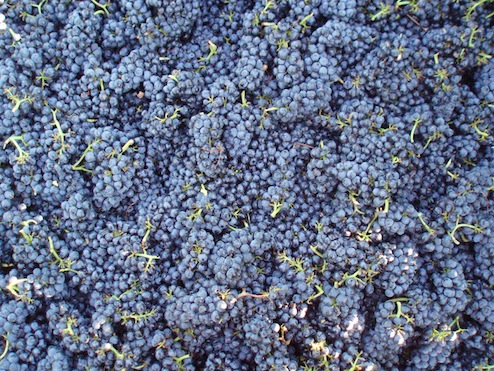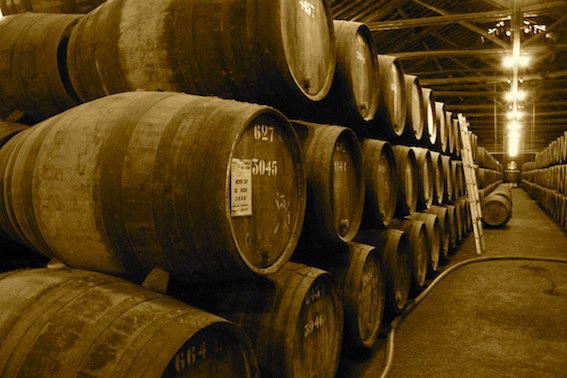Here is a lexicon of definitions of key wine words. The definitions are not intended to be scientifically objective and, in many cases, will be somewhat simplistic. Some will describe the technical side of wine(s), others will examine the more abstract and aesthetic ideas behind wine.
Previously: A’s, B’s, C’s, D’s , E’s, F’s, G’s, H’s, I’s, J’s,K’s,L’s N’s, O’s, P’s, Q&R’s, and S’s (that’s right, this is so unalternative we’re even posting alphabetically…)
Tannins. When we think of tannins we think of red wines and the natural property that gives them a certain texture. Tannins are, in fact, a form of astringent chemical compounds that belong to a larger group called polyphenols. They occur abundantly in nature, namely in the bark of many trees and in a variety of leaves, legumes and fruits, including grapes. Certain teas are high in tannins. Because tannins bind with other proteins, including those in human saliva, they create a characteristic astringent, mouth-coating sensation in the mouth. Tannins in wine come primarily from the skin, seeds and the stems of the grapes. During fermentation, the juice, skins and pips and occasionally stems macerate together. As sugar is processed and alcohol produced, colour and tannin are released into the wine – alcohol will dissolve more tannins than water and therefore the longer the skins and pips macerate during and after fermentation the more tannic the final wine will be. White grapes made with extended skin maceration will develop a tannic structure similar to wines made from red grapes. Tannins can also come from the wood vessels in which a wine is fermented and/or aged. Wood can impart both tannins and flavour to wine.
Tannins can be best described through the tactile sensations they produce and are traditionally expressed in tasting notes in terms of their quantity and quality as well as their integration into the wine’s structure. Textural characteristics may range from soft, velvety and silky at one end of the spectrum to fine, chalky, grippy, grainy, drying or coarse at the other. The tannins will affect the perception of the fruit flavours accordingly. Another important differentiation to make is astringency vs. bitterness, terms that are often conflated. Bitterness is a taste character while astringency is a textural sensation. Even though tannins are not flavour compounds, they can produce a feeling of bitterness in addition to the mouth-coating grip. This is particularly true for young red and orange/amber wines.

Some grapes are naturally higher in tannins than others. In general, and because tannins are predominantly in the skins and seeds of each grape, varieties with thicker skins will have the potential to produce wines with higher tannins. In terms of winemaking, decisions such as fermentation temperature, length of maceration (how long the juice stays in contact with the grapes’ skins), number and vigour of punch-downs or even the type of yeasts used will have an impact on the amount of tannins that are extracted from the grapes and leached into the wine. Finally, tannins do play an important role in wine ageing. Evolution of grape tannins and the tannins imparted by wood contribute to changing aroma, flavour and textural characteristics over time. The nature and number of tannins change naturally: the tannin molecules will gradually polymerise (combine to form larger chains) and eventually precipitate as sediment. Once polymerised the tannins will no longer impart any bitterness or astringency effect. But as key structural components, the presence of tannins will give wine more longevity – that ‘grip’ caused by tannic astringency will make wines feel ‘fresher’ as the primary fruit aromas get lost.
A lot of natural red wines are made with gentle extraction or use methods such as carbonic or semi-carbonic maceration to focus on the purity of the fruit. These wines, by definition, possess less tannic structure than others. Others, of course, have greater intensity and are intended to age and develop; their tannins will derive from the quality of the fruit rather than the grain of the oak. Tannins may be found in amber wine that undergo a certain length of maceration. Some varieties, such as Rebula/Ribolla Gialla, being small and thick-skinned, create wines that have complex tannic structure.
Tartrates. Harmless crystals resembling shards of glass that may form during fermentation or bottle aging (often on the cork) as tartaric acid naturally present in wine precipitates out of solution. Components of tartaric acid, including potassium bitartrate and cream of tartar, are less soluble in alcoholic solutions than in grape juice and solidify at cooler temperatures (such as those found in a refrigerator); can be avoided in finished wines through cold stabilization. Decanting and careful pouring can prevent transferring the crystals from the bottle into the glass. Also known as wine diamonds. Visible tartrates are the badges or jewels of honour in natural wine.
Temperature. As yeasts convert grape sugars into alcohol, they also produce heat. Excessively high temperatures can kill the yeasts and make the wine’s fruit flavours seem stewed or dull, whereas cooler temperatures maintain the freshness of the fruit. Cold fermentations though can also result in confected fruit aromas and flavours such as bubblegum or boiled sweets. Just the right amount of warmth can contribute a richer, rounder mouthfeel. Ambient ferments are those to allow the wine to ferment at whatever the room/cellar temperature might be, without using external means to modify that temperature. Long cool ferments are said to be good for acquiring complex aroma and flavour profiles. Temperature is also something to consider in the storage and the serving of a wine. Wine prefers to be stored a fairly constant cool temperature, and every wine has its ideal/preferred temperature to be served at.

Terroir. The same vine has a different value in different places (Pliny on terroir). Terroir is the aggregate of all the unique factors that come into play in a vineyard and help to shape the final wine. These include climate (macro, meso and microclimate (in particular), aspect of the vines (i.e. in which direction the vines face); altitude; topsoil, drainage, subsoil, vegetation and biodiversity. Terroir goes wider to incorporate aspects of local culture including viticultural history (vine training, local farming practices) and even gastronomy. All these diverse elements may combine to imprint themselves on the wine. Terroir is a French term and expressed, as often as not, as a feeling or sensation – gout-à-terroir – and describes flavours that are not to do with the grape variety or the fermentation or maturation process. Perhaps the most common descriptors of terroir revolve around minerality as much of the energy that goes into a wine derives from the soils in which the plants have their roots. It could be said that energy derives from light as well and other ways in which the vineyard is set up. Wines are more likely to exhibit facets of their terroir, if they come from grapes grown on healthy soils in a lively environment, so organic/biodynamic practices are preferable as well as careful handling and selection of grapes. Terroir can also be undone in the winery by too much technical intervention and also too little, wherein bacterial influences become malign. The preservation of the sensation of terroir in any wine is a kind of genius. Here is the late Mike Weersing on the subject: Wine to us is a genie, genius loci; our task is to coax it from its stone bottle. Wine’s magical capacity for evoking site, we consider an obligation, as much as a gift. Every gesture we make, in the vineyard and winery, is a summons to the spirit of place. Biodynamics, hand-based viticulture, natural winemaking – these are all means we’ve adopted better to record and to transmit, with the greatest possible fidelity, this spirit’s song.
Tertiary aromas. If primary aromas are associated with varietal and fermentation, and secondary ones are to do with the elevage of the wine, then tertiary aromas speak of the aromatic profile of the wine with a degree of age. After a certain period of time, the characteristic fruity elements of the wine in question will have faded to be replaced by variegated autumnal notes – earthiness, mushroom/truffle, smokiness, furniture, old books, wet leaves or on white wines, honey and spice. Certain grape varieties may showcase these aromatics rather beautifully: Pinot Noir and Nebbiolo, in particular, seem to embrace the maxim “the more they fade, the more they come to life.”
Thin. Describes a wine that lacks body or texture. A thin wine differs to one that is lean or sinewy, in that it also has no structural features, no skeleton, as it were.
Tight. A wine that is not expressive. This may be for several reasons. It can be to do with nature of the grape or the winemaking method. High tannins and firm acidity may make a wine tight. So can an extended period of ageing on the lees or in inox, manifested in the form of reduction. Wine also goes through phases after bottling and may be open or closed accordingly. Sometimes exposing the wine to oxygen relaxes it and reduces the tightness.
Toast. When a barrel is being made, but before the heads at either end are put in place, the cooper chars the inside edges of the staves. This final treatment imparts aromas of vanilla, spice and smoke to the wood and then the wine. Char levels include light, medium and heavy toast. Winemakers order barrels with their favourite levels of toast to influence their wine styles. It became the norm amongst certain oenologists to push maturation of the grapes in the vineyard in order to allow the wines to be fermented and aged in new barrels with heavier toasts. This is a big no-no in the natural wine world where oak flavours are considered to be a superimposition of unwonted flavour, something that is fundamentally not part of the wine itself.

Toasty. Describes a flavour derived from the oak barrels in which wines are aged. Also, a taste characteristic that develops in certain wines such as champagne or Hunter Valley Semillon after a few years in bottle.
Transparency. Cleanness and clearness are valued in wine because they are synonymous with reliability. Such properties, however, may be the result of chemical stabilisation, rather inherent to the wine itself. Colour stabilisation tells us about process, and not about the wine itself. Colour is far more than the clear/not clear, it is the spectrum, it is subjective judgement, it is off the spectrum, it is the appeal to the imagination and memory. Colour can tell us much, but looking at colour and receiving its energy, can be the start of a more consuming wine-response. So rather than white, red, yellow, pink, we should be reacting to depth, density, intensity, shininess, and even where the colour seems to hold the light in a particular way, because these intrinsic properties challenge our brain to search for words (similes or metaphors) or rather dial up previous experiences to put into words to describe the complexity of the appearance. Transparency also refers to “transparency of terroir”, the impression that the wine speaks clearly of its origins and has not been muddled by clumsy oenological intervention. It is thus synonymous with purity.
Typicity. A term used interchangeably with terroir and also linked with definitions concerning appellation. Regarding the latter, the notion of typicity is often bound up in consistency. Regulations about what is a typical wine from a certain place were instituted to declare certain minimum standards, to highlight also native grape varieties and to give consumers an idea of style. However, these regulations have stifled individuality and enterprise and, if anything, have led to greater conformity and homogeneity. Real typicity involves respecting the particularity of the terroir and capturing it by means of first-class farming methods and sympathetic winemaking. The wine then expresses a truth about the place and the vintage.

